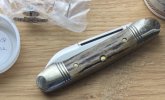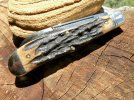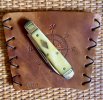- Joined
- Dec 24, 2009
- Messages
- 95
Genuine stag was more common in the earlier years. Those were the only ones that came with the hat pin because they weren't shielded. As the years went by, GEC's use of genuine stag was less common. Looking over the production numbers it seems 2014 was the last year used on 7 pcs. of #78's. Burnt stag and natural stag were shielded so no hat pins. Seems like when they switched to sambar stag they opted out of both shields and hat pins.
























